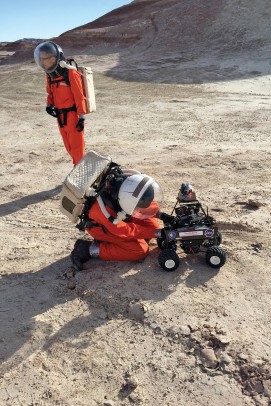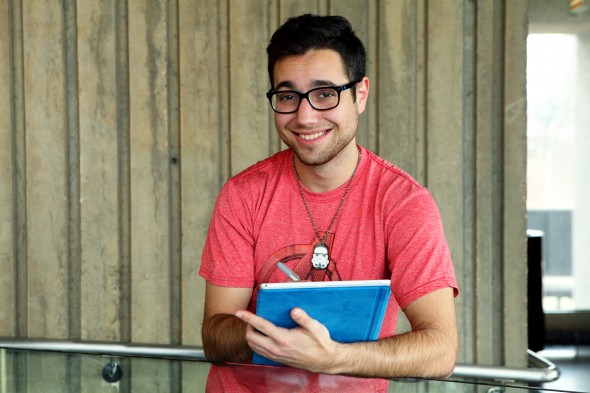UIC student’s out of this world experience
Barak Stoltz wasn’t on Mars, but it was the next thing to it — a station in the Utah desert that duplicates the harsh conditions astronauts will face when they get to the Red Planet.
Stoltz, a junior in mechanical engineering and physics, spent two weeks in December at the Mars Desert Research Station.
The station is run by the Mars Society, a nonprofit that calls itself “the world’s largest and most influential space advocacy organization” and “works toward a human presence” on Mars.

Barak Stoltz spent two weeks at the Mars Desert Research Station in Utah. “It’s for people who want the experience of being an astronaut,” he says.
“It’s a full-scale approximation of what they would send to Mars,” Stoltz said. “It’s for people who want the experience of being an astronaut on the first [Mars] mission.”
He and his six fellow crew members had to wear spacesuits whenever they went outside. They ate dehydrated food.
“Rehydrated, it tastes about the same,” he said. “We had potatoes, vegetables, sausage, chicken, beef, even cheese. Once we even made pizza,” although it made everyone gassy.
Geologically, the Utah desert is much like Mars. Another resemblance: “The isolation,” Stoltz noted.
“I was fancily named the astro-engineer. I worked at the Musk Observatory [Elon Musk, CEO of SpaceX, donated it], fixing up the telescope, recreating the training program that any future crew astronomer will have to go through.”
Stoltz valued the diversity of his crew, which included members from Australia, India and Italy.
As a Jew born in Israel, he marked Hanukkah by telling the story behind the holiday, lighting a menorah, saying a prayer, singing a song and “attempting to make latke.”
“It was an opportunity for people from different cultures to learn and share,” he said.
Now that he’s gone through the simulation, is he interested in actually going to Mars some day?
“Absolutely,” said Stoltz, who guesses that the first trips will start around 2030-2040. The trip will take about six months.
“I’m definitely willing to put up a fight to get picked,” he said. “Crew members will basically have to be as elite in your field as can be found — engineers, medical, pilots — picked out of thousands.”
Planners are improving the technology to make the trip more affordable and practical, he said. “Mars has a scarce magnetic field that doesn’t cover the whole planet, nothing to protect astronauts from radiation.
“Companies like SpaceX are working to make rockets more affordable. For the first time they launched a cargo into orbit; it spun around, came back down and landed. They can refuel and send it up again, saving millions of dollars.”
The Utah station has hosted 161 crews, with more than 1,000 members, since opening in 2001.
Stoltz’s father, Michael, is director of media and public relations for the Mars Society. A year ago, he mentioned to his son that one of the upcoming crews was short one member. Barak applied and was named to crew No. 159 about a month later.
Born in Israel, he came to this country in 2007 at age 12. His family’s home is in Northbrook; he lives on Taylor Street about 10 minutes from campus.
At UIC he works under Alexander Yarin, professor of mechanical and industrial engineering, and Ph.D. student Sumit Sinha Ray.
“We’re working on production, modification and application of nanofibers,” he said.
Stoltz plans to pursue a master’s degree and perhaps a Ph.D., then work for SpaceX, NASA or a space-oriented company like Lockheed Martin.
His career will involve “anything engineering-, space- or science-related,” he said. “Anything pushing humanity forward.”
Mars is never far from his thoughts.
“A successful manned mission to Mars would be one of the biggest accomplishments in human history, and being a part of it would be an absolute pleasure,” Stoltz said.
“As an enthusiastic believer in the future of space travel, I believe that our mind should wonder at the thought of space exploration, and what better way to do so than in the middle of the Utah desert with a sky full of stars.”
Categories

